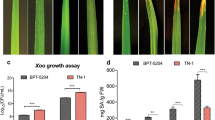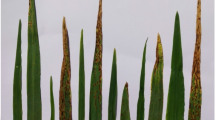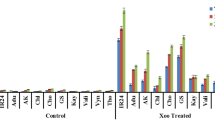Abstract
Spot blotch caused by Bipolaris sorokiniana, is one of the major diseases of wheat in the humid and warmer wheat growing areas of India. Among the eight wheat genotypes that were evaluated with diverse ten B. sorokiniana isolates, Chirya 7 was found highly resistant to spot blotch and BS-112 was most aggressive isolate in comparison to other isolates. Relative expression analysis showed that eight defense-related genes (chitinase, glucanase, PR-1, Lipid transfer protein, Serine palmitoyl transferase, UDP-glycosyl transferase, Translationally controlled tumor protein, dnaJ-like) in wheat were highly expressed in resistant genotype (Chirya 7) as compared to susceptible cultivar, Sonalika. Furthermore, chitinase gene was up regulated to maximum level (12.42 fold) at 72 hai (hours after inoculation) in the resistant genotype, Chirya 7. Similarly, pathogenesis related-1 protein gene was showed up regulation (8.31 fold) at 24 hai; and predicted dnaJ homolog subfamily C member 8-like gene showed high up regulation at 48 hai; UDP-glycosyltransferase (UGTs) gene was highly expressed at 24 hai and predicted serine palmitoyl transferase gene showed early expression (9.22 fold) in resistant genotype. Translationally controlled tumor protein (TCTP) gene was also highly expressed at early stage. Overall, Chirya 7 genotype had shown highest transcripts during host–pathogen interaction as compared to Sonalika against most virulent isolate of BS-112, thereby indicating that resistant genotype Chirya 7 was having various defense-related genes and could serve as potential donor for spot blotch resistance breeding in wheat.



Similar content being viewed by others
References
Adlakha KL, Wilcoxson HD, Raychaudhury SP (1984) Resistance of wheat to leaf spot caused by Bipolaris sorokiniana. Plant Dis 68:320–321
Aggarwal PK, Talukdar KK and Mall RK (2000). Potential yields of rice- wheat system in the Indo-Gangetic Plains of India. In: Consortium paper series 10. Rice-wheat consortium for the Indo-Gangetic Plains, New Delhi, India. p. 16
Aggarwal R, Das S, Jahani M, Singh DV (2008) Histopathology of spot blotch [Bipolaris sorokiniana (teleomorph: Cochliobolus sativus)] infection in wheat. Acta Phytopathol 43:23–30
Aggarwal R, Singh VB, Gurjar MS, Sangeeta Gupta, Srinivas P (2009) Intraspecific variations in Indian isolates of Bipolaris sorokiniana infecting wheat, based on morphological, pathogenic and molecular characters. Indian Phytopath 62(4):449–460
Berkey R, Bendigeri D, Xiao S (2012) Sphingolipids and plant defense/disease: the “death” connection and beyond. Front Plant Sci. 3:68
Chenulu VV, Singh A (1964) A note on estimation of losses due to leaf blight of wheat caused by Alternaria triticina. Indian Phytopath 17:354–356
Dubin HJ, Van Ginkle M (1991) The status of wheat diseases and disease research in warmer area. Wheat for the non-traditional warmer areas. CIMMYT, D.F., Mexico, pp 125–145
Duveiller E and Gilchrist LI (1994). Production constraints due to Bipolaris sorokiniana in wheat: current situation and future prospects. In: Saunders D, Hettel G, eds. In: Wheat in Heat-Stressed Environments: Irrigated, Dry Areas and Rice-Wheat Farming Systems. Proceedings of the CIMMYT/UNDP workshop, Nashipur (Dinajpur), Bangladesh, February 13–16, 1993, 343:52
Duveiller EM, Sharma RC (2009) Genetic improvement and crop management strategies to minimize yield losses in warm non-traditional wheat growing areas due to spot blotch pathogen Cochliobolus sativus. J Phytopath 157(9):521–534
Fabro G, Di Rienzo JA, Voigt CA, Savchenko T, Dehesh K, Somerville S, Alvarez ME (2008) Genome-wide expression profiling Arabidopsis at the stage of Golovinomyces cichoracearum haustorium formation. Plant Physiol 146:1421–1439
Honnareddy N, Aggarwal R, Sharma S, Gupta S, Singh G, Bashyal BM, Ranebennur H (2014) Isolation and identification of defense responsive genes in wheat during incompatible interaction with Bipolaris sorokiniana (Cochliobolus sativus) using SSH Technique. Vegetos 27(3):11–20
Joshi AK, Chand R (2002) Variation and inheritance of leaf angle and its association with spot blotch (Bipolaris sorokiniana) severity in wheat (Triticum aestivum). Euphytica 124:283–291
Joshi AK, Ortiz-Ferrara G, Crossa J, Singh G, Alvarado G, Bhatta MR, Duveiller E, Sharma RC, Pandit DB, Siddique AB, Das SY, Sharma RN, Chand RB (2007) Associations of environments in South Asia based on spot blotch disease of wheat caused by Cochliobolus sativus. Crop Sci 47:10711–10811
Kosaka A, Manickavelu A, Kajihara D, Nakagawa H, Ban T (2015) Altered gene expression profiles of wheat genotypes against Fusarium head blight. Toxins 7:604–620
Liu JZ, Whitham SA (2013) Overexpression of a soybean nuclear localized type-III DnaJ domain-containing HSP40 reveals its roles in cell death and disease resistance. Plant J 74:110–121
Livak KJ, Schmittgen TD (2001) Analysis of relative gene expression data using real-time quantitative PCR and the 2*ΔΔCT method. Methods 25(4):402–408
Ng TB, Cheung RCF, Wong JH, Ye X (2012) Lipid-transfer proteins. Pept Sci 98:268–279
Sahu R, Sharaff M, Pradhan M, Sethi A, Bandyopadhyay T, Mishra VK, Chand R, Chowdhury AK, Joshi AK, Pandey SP (2016) Elucidation of defense-related signaling responses to spot blotch infection in bread wheat (Triticum aestivum L.). Plant J 86:35–49
Schafer P, Huckelhoven R, Kogel KH (2004) The white barley mutants albostrians show a super-susceptible but symptom less interaction phenotype with the hemibiotrophic fungus Bipolaris sorokiniana. Mol Plant Microbe Interact 17:366–373
Sharma AK, Kumar J, Nagarajan S (1998) Disease management strategy in wheat. Indian Farming 18:52–53
van Loon LC, Rep M, Pieterse CM (2006) Significance of inducible defense-related proteins in infected plants. Annu Rev Phytopathol 44:135–162
Zhu F, Xu M, Wang S, Jia S, Zhang P, Lin H, Xi D (2012) Prokaryotic expression of pathogenesis related protein 1 gene from Nicotiana benthamiana: antifungal activity and preparation of its polyclonal antibody. Biotechnol Lett 34:919–924
Author information
Authors and Affiliations
Corresponding author
Rights and permissions
About this article
Cite this article
Gurjar, M.S., Bhardwaj, N.R., Jain, S. et al. Identification of resistance sources and expression level of defense-related genes in wheat against Bipolaris sorokiniana. Indian Phytopathology 71, 127–134 (2018). https://doi.org/10.1007/s42360-018-0020-4
Received:
Accepted:
Published:
Issue Date:
DOI: https://doi.org/10.1007/s42360-018-0020-4




